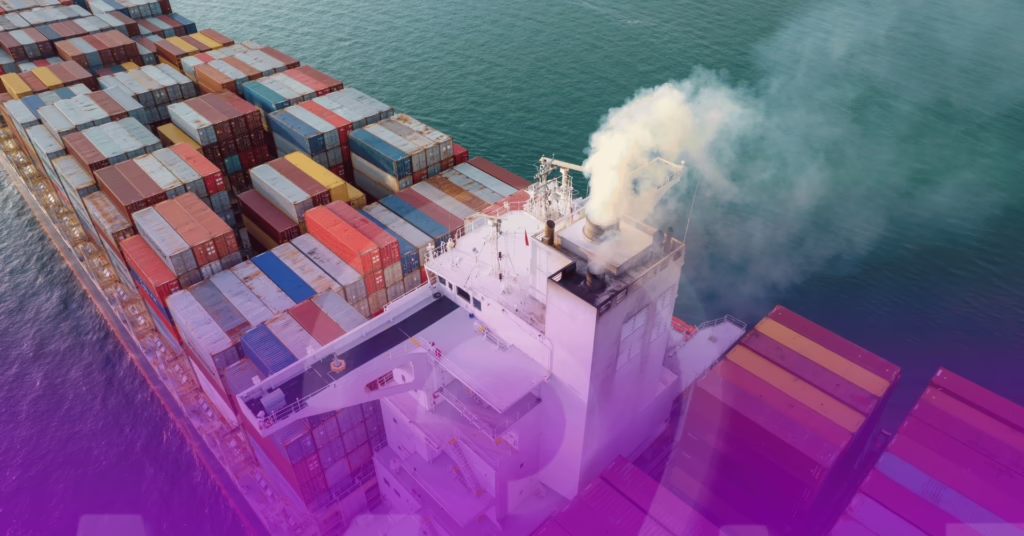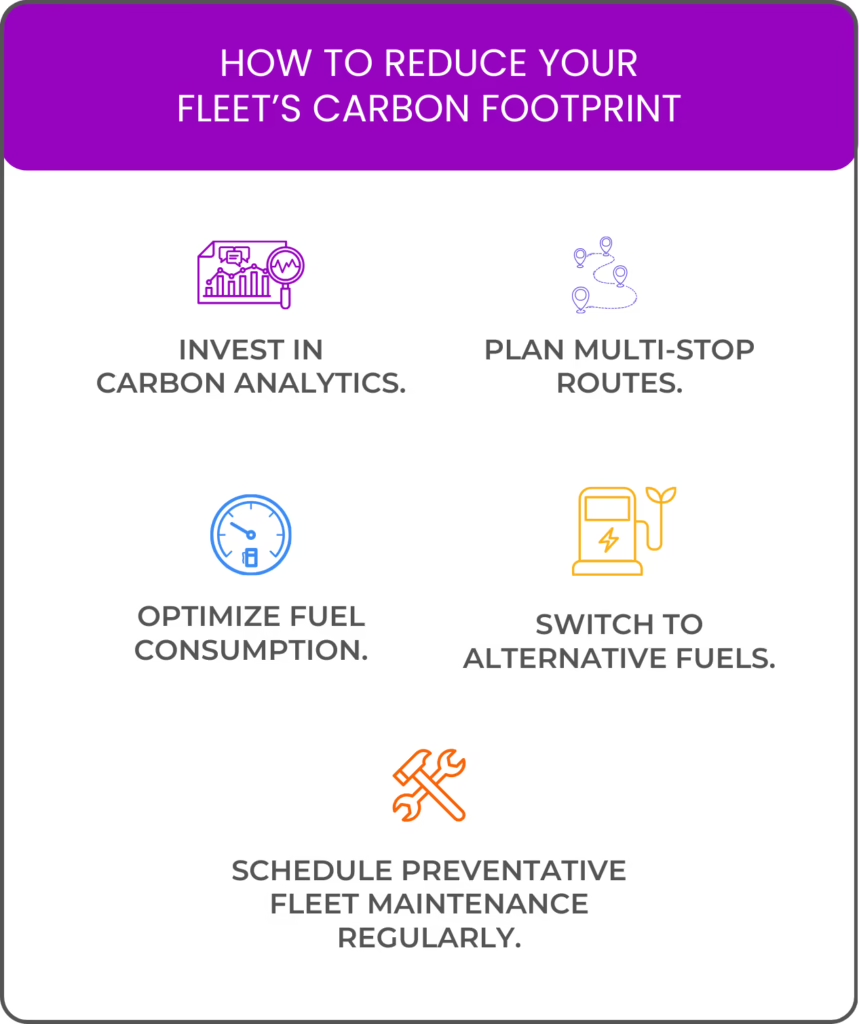
How to Lower Your Fleet’s Carbon Emissions for Sustainable Logistics
The old adage, ‘The best time to plant a tree was 20 years ago. The second-best time is now,’ has never been truer than it is today.
Climate change is a growing concern all over the world. Governments, businesses, and environmental organizations have all joined forces in their race to reach “net zero” by 2050. This collective urgency to combat climate change has also reshaped the corporate world’s priorities.
In recent years, the corporate sector has witnessed a seismic shift in how success is measured. Previously, productivity and profitability were the primary benchmarks of a successful business. However, lately, a new set of criteria centered on environmental, social, and governance (ESG) factors has taken center stage. Now, businesses, no matter big or small, are increasingly judged by their impact on the environment, society, and individuals.
At the same time, both consumers and employees are showing a clear preference for organizations that put sustainability and ethical practices before everything else. The growing demand for transparency has made sustainability a non-negotiable principle in corporate strategy, especially in the transport and logistics sector, which accounts for around one-fifth of global carbon dioxide emissions.
But what exactly does ESG mean for fleet operations, and why is it so important? Let’s explore the key aspects and benefits of integrating ESG into fleet management.
What Is ESG in Fleet Management?
ESG in fleet management involves practices that assess a fleet’s sustainability and ethical footprint and align its operations with the company’s broader environmental and societal responsibilities.
- Environmental Focus: This aspect lays emphasis on reducing CO₂ emissions, optimizing vehicle routes, and implementing eco-driving initiatives to minimize environmental harm.
- Social Responsibility: This covers ensuring fair working conditions, prioritizing employee safety, and promoting inclusivity within the workforce.
- Governance Practices: Governance entails maintaining transparency, ensuring ethical operations, and complying with carbon reporting standards. For fleets, this could include accurate tracking of emissions and adhering to data privacy laws.
Why ESG Matters for Fleets
Not long ago, ESG considerations were little more than a peripheral issue for most logistics businesses. However, changes in societal expectations and increasingly stringent government regulations have catapulted ESG into the limelight. If you fail to meet these expectations, be prepared to face the consequences, which can range from reputational damage to financial penalties.
For fleet managers, the implications are particularly pronounced. ESG reporting is no longer just a box to tick on a to-do list. It has become a prerequisite for fleet compliance in sustainable logistics.
Breaking Down ESG Reporting in Fleet Operations
ESG reporting focuses heavily on emissions, which are typically categorized into three scopes:
- Scope 1 – Direct Emissions: These are greenhouse gas emissions produced directly by fleet vehicles by way of fuel combustion.
- Scope 2 – Indirect Emissions: These emissions arise from energy used to power fleet operations, such as electricity for charging electric vehicles.
- Scope 3 – Supply Chain Emissions: Perhaps the most challenging to manage, these emissions stem from upstream and downstream activities, like supply chain transport and delivery operations.
Scope 3 emissions often make up the largest share of a fleet’s total carbon footprint. Therefore, regulators and stakeholders insist on detailed reports on these emissions, along with a clear plan for reduction.
5 Practical Ways Logistics Companies Can Reduce Their Fleet’s Carbon Emissions
Reporting is essential — there’s no denying it. It demonstrates a company’s genuine progress towards achieving fleet sustainability, but it’s only part of the equation. To make a meaningful impact, fleet managers must take proactive steps to lower their fleet’s carbon footprint.
Here’s how.

1. Invest in Carbon Analytics
Needless to say, this would require a robust technology stack with intuitive BI dashboards and a dynamic IT infrastructure to track carbon emissions at granular level. And yes, that would mean a decent amount of investment for successful implementation. But with time, this technological transformation will yield impressive returns and steadily decrease your fleet’s carbon emissions through proactive sustainability measures.
Also, consider looking into frameworks such as the Global Logistics Emissions Council (GLEC) for guidance on how to measure carbon emissions. Once you’ve calculated your carbon footprint, establish realistic daily carbon emission targets. Set limits for distance traveled and fuel consumed by each vehicle. When a vehicle reaches its threshold, remove it from the daily roster and reassign its tasks to an electric or hybrid vehicle.
2. Plan Multi-Stop Routes
Interestingly, the most efficient routes are often the ones with the lowest carbon emissions. Yesterday, you would provide your drivers with complete journey plans with precise geographical coordinates and delivery time windows so that all orders are delivered at the right address and as per schedule.
Today, to add a layer of sustainability to your operations, you must make sure their journey plans have multi-pickup and multi-drop off routes to save a second trip for product returns and prevent empty vehicle runs to and from the depot. It sounds like hours of manual work but will hardly take a minute if you have a good delivery management system in place with a built-in, multi-stop route planner.
3. Optimize Fuel Consumption
Not only does a fuel-efficient fleet cut down greenhouse gases released into the atmosphere, it also lowers the operational costs associated with fuel replenishment. But unfortunately, factors like global fuel prices, fuel theft, vehicle depreciation, and driver behaviour can undermine the efficiency of even the most well-planned logistics operations.
Underinflated tires, too, can increase drag and fuel consumption considerably. Every 1% drop in tire pressure correlates with a 0.3% decrease in fuel economy. Over time, this adds up, both financially and environmentally.
Implement a logistics management software that can alert your fleet manager to anomalies like high fuel consumption or fuel theft in real time. It should also flag inefficient routes, faulty vehicle performance, underinflated tires, harsh braking, or vehicle idle time, and send notifications so that your team can take corrective measures instantly.
4. Switch to Alternative Fuels
Equally important is the adoption of cleaner fuels. Some carriers have already incorporated biofuels derived from renewable resources, which reduce emissions substantially. Liquefied natural gas (LNG), though not entirely carbon-neutral, is another viable alternative that emits far less carbon dioxide than traditional fuels.
On a broader scale, this shift towards low-emission vehicles extends beyond ocean freight. Electric vehicles (EVs), even after accounting for electricity generation, produce far fewer emissions than conventional internal combustion engine vehicles. So do hybrid and hydrogen-powered vehicles.
5. Schedule Preventative Fleet Maintenance Regularly
Poorly maintained vehicles with faulty parts or clogged components consume more fuel, and therefore, emit more greenhouse gases.
Make sure your logistics management software streamlines preventative maintenance with real-time diagnostics, schedules, and service plans. It must also notify fleet managers of engine faults, worn brake pads, or fluctuating oil and water levels. Regular maintenance not only extends the lifespan of your vehicles but, when made part of daily operations, ensures they burn less fuel and perform at their best while on the road. Every liter of fuel saved means 2.68 kg less carbon dioxide will be released into the air.
Next Steps
The global push toward sustainability is reshaping industries, and fleet management is no exception.
Of course, integrating ESG into fleet management has a steep learning curve. Also, the process requires a large capital injection, both in terms of time and resources. But the long-term benefits far outweigh the costs.
Implement these strategies and make your fleet more environmentally friendly.
Better yet, start your journey toward sustainable fleet management with Mile’s sustainable logistics software.
